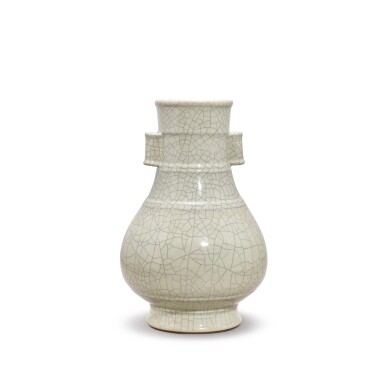Auctions
Buy Now
Collectibles & More
Books & Manuscripts
Chinese Art
Chinese Art

Auction Closed
September 18, 08:03 PM GMT
Estimate
1,000,000 - 1,500,000 USD
Lot Details
Description
the base with a six-character seal mark in underglaze blue
Height 12¾ in., 32.4 cm
Collection of Arthur J. Whittall, acquired in the 1920s-30s.
Bluett's & Sons Ltd., London, 19th May 1948.
Collection of Lord Cunliffe (1899-1963).
Bluett & Sons Ltd., London, Grosvenor House Fair, 14th June 1978.
Hugh Moss, London.
Sotheby's Hong Kong, 28th November 1979, lot 299.
Sotheby's New York, 4th December 1985, lot 256.
Collection of Morton and Grace Gordon.
Christie's New York, 24th March 2011, lot 1120.
Grosvenor House Antiques Fair, London, 1978.
Covered in a creamy-white glaze suffused with a captivating web of crackles, the present vase is a magnificent example of the Song-imitation ceramics produced during the brief reign of the Yongzheng Emperor (1723-1735).
While the ravishing crackle glazes of the Song dynasty enjoyed an unbroken history of appreciation throughout the Ming and Qing dynasties, the most exceptional reproductions were produced during the Yongzheng period. Yongzheng's personal appreciation of antique ceramics and exacting standards pushed artisans at the imperial kilns in Jingdezhen to develop better and better reproductions of Song glazes, even going so far as to send Song originals from the court collection as study pieces to replicate. Especially following the appointment of the famed superintendent of the imperial kilns, Tang Ying, in the sixth year of the Yongzheng reign, this period saw a growing demand for such magnificent pieces with subtle forms and minimal decoration.
Although a number of related pieces of Ge ware are known that may have served as prototype for the present vase, reference must also be made to Song dynasty Longquan wares which feature similarly rounded bellies and molded bowstring designs. Compare a number of smaller Ge ware vases of related form from the collection of the Qing Court, illustrated in The Complete Collection of Treasures of the Palace Museum: Porcelain of the Song Dynasty (II), Hong Kong, 1996, pls 39-44; and a similar Longquan vase from the collection of the Palace Museum, Taipei, illustrated in Porcelain of the National Palace Museum: Lung-Chüan Ware of the Sung Dynasty, Hong Kong, 1962, pl. 3.
These beloved Song pieces, with dramatic foot rings and tubular handles, were in turn derived from archaic bronze hu vessels. Compare, for example, a related Shang dynasty hu preserved in the Palace Museum, Beijing, illustrated in The Complete Collection of Treasures of the Palace Museum: Bronze Ritual Vessels and Musical Instruments, Hong Kong, 2006, pl. 92.
However, unlike the Song vases and the more conventional replicas produced during the Qianlong period, the most magnificent of Yongzheng pieces – the present lot a prime example – move far beyond mere imitation and possess an ineffable sense of vitality as masterpieces in their own right. With smooth bulbous bellies and imposing splayed feet, these pieces may even be said to be closer in style to their ancient bronze predecessors than to their so-called prototypes from the Song dynasty.
Very few Ge-type vases of this period are known and almost none of this magnificent quality. Compare a slightly smaller Ge-imitation vase from the Huaihaitang Collection, exhibited in Ethereal Elegance: Porcelain Vases of the Imperial Qing, Art Museum, The Chinese University of Hong Kong, 2007, cat. no. 39; another sold in our London rooms, 1st June 1988, lot 164; another, without bowstring banding, sold in our Hong Kong rooms, 26th October 1993, lot 96, and again, 7th May 2002, lot 509. Compare also a closely related guan vase of Yongzheng mark, also of slightly more compressed form, sold three times in our London rooms in 1982, 2001, 2006 and, finally, in our Hong Kong rooms, 8th October 2009, lot 1637.
Another Yongzheng vessel of related shape but with a flambé glaze is in the Palace Museum, Beijing and illustrated in The Complete Collection of Treasures of the Palace Museum: Monochrome Porcelain, Hong Kong, 1999, pl. 180.